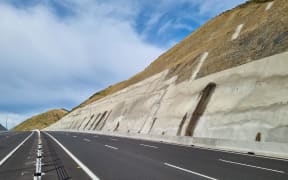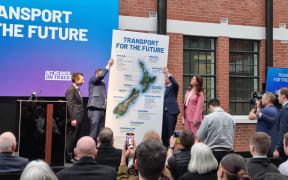
Transmission Gully Photo: RNZ / Angus Dreaver
Waka Kotahi has been making exaggerated claims about how 'green' its highways are.
It wrongly claimed online that the Transmission Gully motorway and three other big highways were independently, internationally certified for sustainability when they have not been.
This has come to light amid investigations into the highway's impacts on fish, streams and Porirua Harbour.
Earlier, during construction, the project incurred over $100,000 in fines for scores of environmental breaches, as well as costing almost $7 million for environmental monitoring by the regional council.
The transport agency's website carries the statement: "Transmission Gully will be the first motorway constructed in New Zealand to achieve Greenroads silver certification."
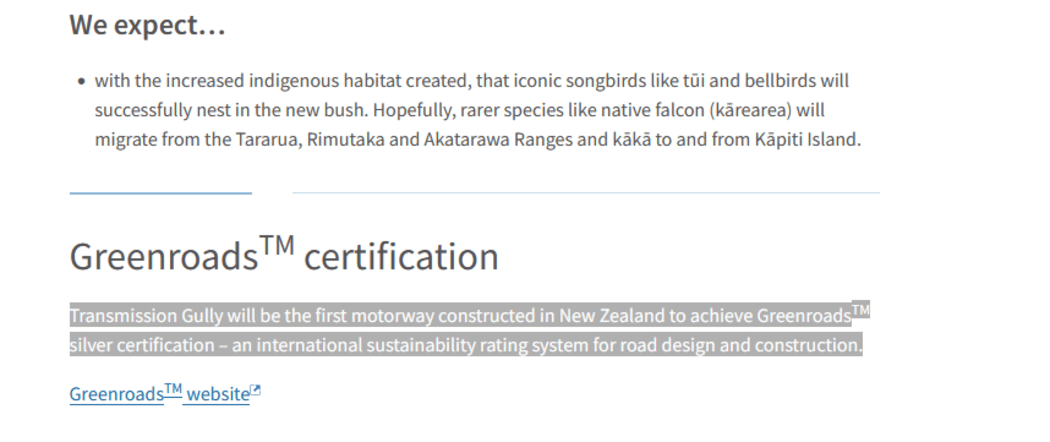
Screenshot of Waka Kotahi website claiming Transmission Gully Greenroads certification. Photo: Supplied / Waka Kotahi
This was "the hope" a few years ago, but instead the motorway got a lesser silver pilot rating, which was "significant", the agency has now told RNZ.
The other three highways, Peka Peka to Ōtaki, Baylink in Tauranga and the Auckland northern corridor improvement, have also been touted on its website as "contractually required" to get assessed through to "final certification" by US certifier Greenroads.
They also will not get certification.
Instead, they had swapped into using "an alternate sustainability framework" developed by Waka Kotahi itself, that aligned with a government-led programme, the agency said on Monday.
The new framework is not independent.
An international model has been maintained, but at 12 other projects, that have been assessed under an Australian-based sustainability rating since late 2020.
Waka Kotahi's website claims about Greenroads are six years out of date.
When RNZ enquired with non-profit US certifier Greenroads about Transmission Gully, it said it was "unfortunate to learn information this way sometimes".
"To confirm, the motorway is not certified today, but it does have a rating, which we use as a more general term," Greenroads head Jeralee Anderson said via email.
"I also want to be very clear that we do consider the Transmission Gully project to be a successful pilot project, and we stand behind this work and the collective achievement of the team."
Roadbuilding is notorious for its huge carbon footprint embodied in its masses of steel and concrete, some of the most emissions-intensive products on earth. Highways once built pose the risk of huge volumes of dirty water running off into catchments.
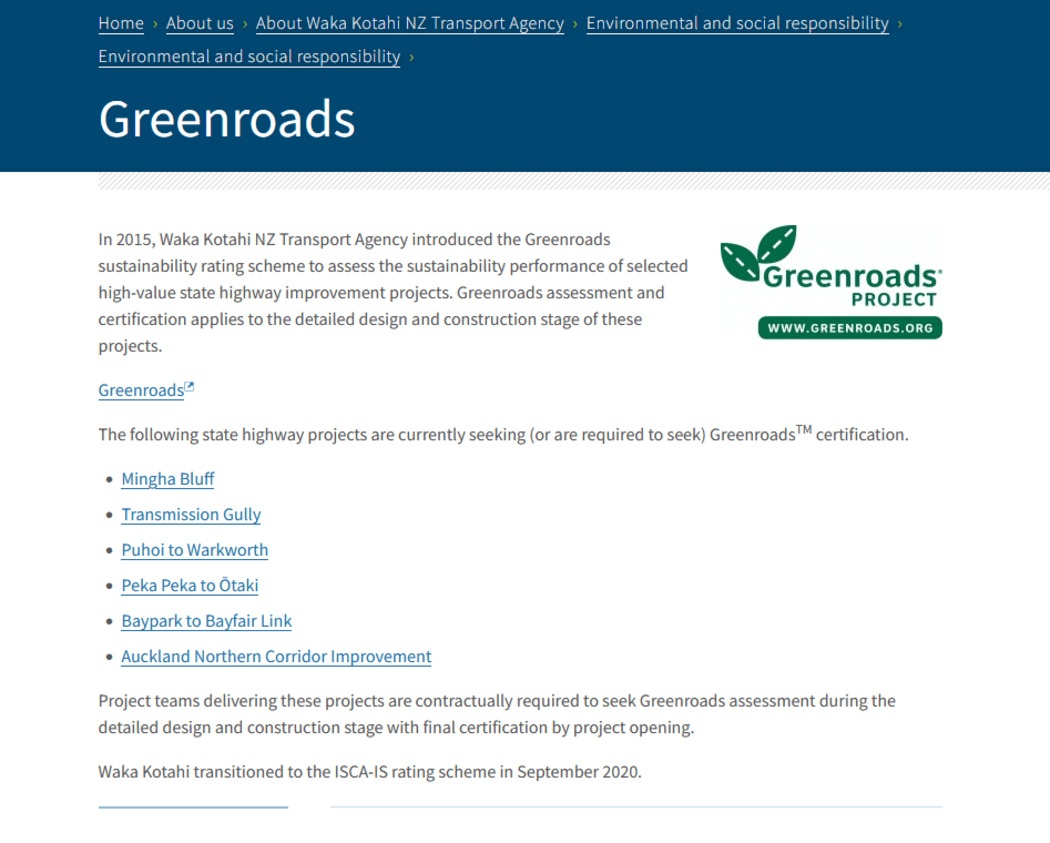
Screenshot of Waka Kotahi website about Transmission Gully Greenroads rating scheme. Photo: Supplied / Waka Kotahi
A Transmission Gully 'works requirement' document, amended in 2020, said the contractor "will ... design and construct the TG Project to achieve not less than a Silver certification".
"The information on the project website was accurate at the time it was originally published but needs to be updated," the agency said.
"The fact that our website has not been fully updated on these matters is because the transition from Greenroads to the alternative reporting framework has been an evolving process. Our website is being updated to reflect this."
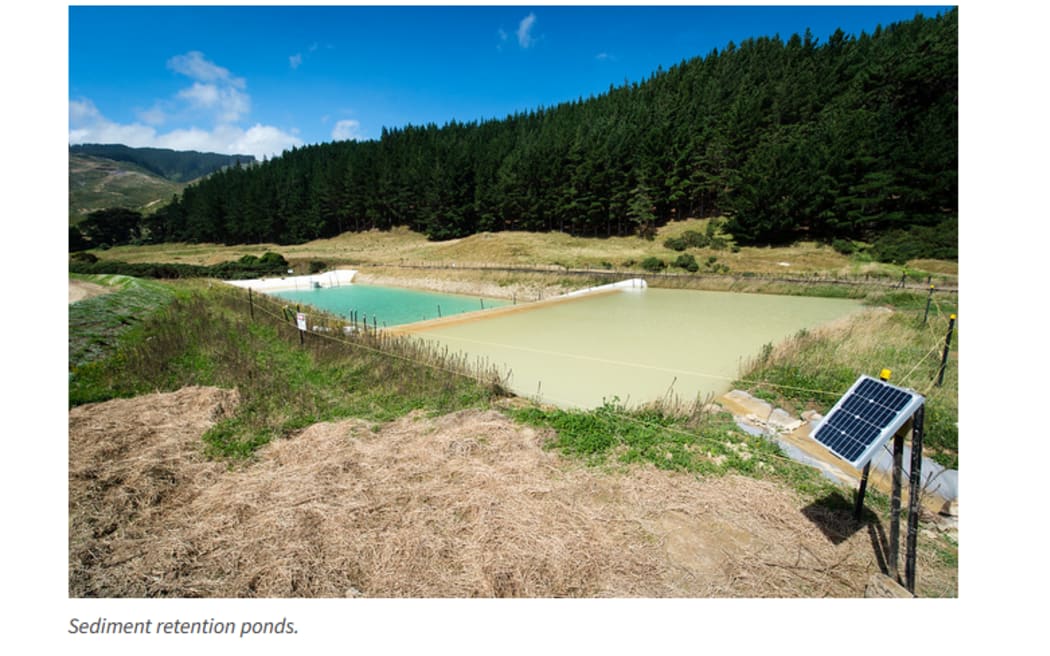
A sedimentation pond at the Transmission Gully motorway. Photo: Supplied / Waka Kotahi
The transport agency pledged Transmission Gully would make the environment a top priority, when it was agreed in 2009 to build it as a Road of National Significance, under a public-private partnership or PPP.
The new coalition government has a policy to build 13 new roads of national significance, and use PPPs more often to fund infrastructure.
The six highway builds obliged to get Greenroads final certification were Transmission Gully, Peka Peka to Ōtaki, Baylink in Tauranga, and the Auckland northern corridor improvement, Mingha Bluff near Arthur's Pass and Pūhoi to Warkworth.
Full certification was not proceeded with for the first four highways, that instead switched to "an alternative framework ... This was done by mutual agreement", the agency said.
"The alternate sustainability reporting framework has been developed specifically for former Greenroads projects by Waka Kotahi to reflect closer alignment with Waka Kotahi and its sustainability priorities."
This is more government-directed than under Greenroads. The framework fits under a "government-wide initiative" called 'Broader Outcomes' that aims to get projects to take into account wider social, economic, cultural and environmental outcomes. The Ministry of Business, Innovation and Employment created this in 2018 and NZTA adopted it in 2021.
Two of the six highways the agency made the claims for, did get an independent certification from Greenroads: The Pūhoi to Warkworth motorway won silver certification a few weeks ago, and Mingha Bluff a bronze certification in 2019.
Green certification in construction is a growing field with its benefits and pitfalls - such as "of greenwashing and free riding" - debated in international studies.
Greenroads, an NGO, said participation in its rating programme was voluntary, and "a participant can start or stop ... at any time".
It had no authority to enforce any terms in a roadbuilding contract to achieve a specific rating or to rectify any shortcomings, Anderson said.
"The entire team invested a lot of effort and time into learning about our programme and we feel their participation and active engagement, led especially by Waka Kotahi at the outset, positively influenced many environmental outcomes and learnings that benefited the agency as well as the roading industry in New Zealand for years to come."
Transmission Gully turned out to be the biggest compliance job the regional council had ever done.
It set up a special team of three to five people who worked for six years from 2016, "solely dedicated to the consenting and compliance work".
This cost about $6.8m, which it recovered or passed on, Greater Wellington said.
Now that monitoring was continuing as business-as-usual, it had led to the investigation of a possible nine breaches.
Waka Kotahi is in a legal dispute with the road's builders over whether the project is completed or not, and this is complicating the breach investigations.
Its Australian-based green rating system, ISC, has applied since late 2020 to new capital projects over $100m.
A dozen are using it: Te Ahu a Turanga (Manawatū Highway); Papakura to Drury S1A;Takitimu North Link; Te Ara Tupua; Papakura to Drury S1B1 and 1B2; Tauriko West Network Enabling Works; Mahurangi (Penlink); Mt Messenger; SH58 Stages 2A and 2B; Additional Waitematā Harbour Connections; North-West rapid transit.


